Characteristics and Driving Mechanisms of Heatwaves in China During July and August
Abstract
1. Introduction
2. Materials and Methods
2.1. Study Area
2.2. Data Collection
2.3. Methodology
2.3.1. Calculation Method of the EHF
2.3.2. Definition of the Characteristics of Heatwaves
3. Results
3.1. Extreme Heat Thresholds
3.2. Heatwave and Its Characterization Analysis
3.3. Relationship Between Heatwaves, Atmospheric Circulation, and Soil Moisture
3.3.1. Atmospheric Circulation and Heatwaves
3.3.2. The Role of Soil Moisture in Driving Heatwaves
4. Discussion
5. Conclusions
Author Contributions
Funding
Institutional Review Board Statement
Informed Consent Statement
Data Availability Statement
Conflicts of Interest
References
- IPCC Climate Change 2023: Synthesis Report. Contribution of Working Groups I, II and III to the Sixth Assessment Report of the Intergovernmental Panel on Climate Change; The Australian National University: Canberra, Australia, 2023; ISBN 92-9169-164-X.
- Perkins-Kirkpatrick, S.E.; Gibson, P.B. Changes in Regional Heatwave Characteristics as a Function of Increasing Global Temperature. Sci. Rep. 2017, 7, 12256. [Google Scholar]
- Dosio, A.; Mentaschi, L.; Fischer, E.M.; Wyser, K. Extreme Heat Waves Under 1.5 °C and 2 °C Global Warming. Environ. Res. Lett. 2018, 13, 54006. [Google Scholar] [CrossRef]
- Perkins-Kirkpatrick, S.E.; Lewis, S.C. Increasing Trends in Regional Heatwaves. Nat. Commun. 2020, 11, 3357. [Google Scholar] [CrossRef]
- García-Herrera, R.; Díaz, J.; Trigo, R.M.; Luterbacher, J.; Fischer, E.M. A Review of the European Summer Heat Wave of 2003. Crit. Rev. Environ. Sci. Technol. 2010, 40, 267–306. [Google Scholar] [CrossRef]
- Monteiro, A.; Carvalho, V.; Oliveira, T.; Sousa, C. Excess Mortality and Morbidity During the July 2006 Heat Wave in Porto, Portugal. Int. J. Biometeorol. 2013, 57, 155–167. [Google Scholar] [CrossRef]
- Rebetez, M.; Dupont, O.; Giroud, M. An Analysis of the July 2006 Heatwave Extent in Europe Compared to the Record Year of 2003. Theor. Appl. Climatol. 2009, 95, 1–7. [Google Scholar] [CrossRef]
- Lee, S.-M.; Min, S.-K. Heat Stress Changes over East Asia Under 1.5 and 2.0 °C Global Warming Targets. J. Clim. 2018, 31, 2819–2831. [Google Scholar] [CrossRef]
- Hoy, A.; Hänsel, S.; Skalak, P.; Ustrnul, Z.; Bochníček, O. The Extreme European Summer of 2015 in a Long-Term Perspective. Int. J. Climatol. 2017, 37, 943–962. [Google Scholar] [CrossRef]
- Krzyżewska, A.; Dyer, J. The August 2015 Mega-Heatwave in Poland in the Context of Past Events. Weather 2018, 73, 207–214. [Google Scholar] [CrossRef]
- Song, X.; Zhang, Z.; Chen, Y.; Wang, P.; Xiang, M.; Shi, P.; Tao, F. Spatiotemporal Changes of Global Extreme Temperature Events (ETEs) since 1981 and the Meteorological Causes. Nat. Hazard. 2014, 70, 975–994. [Google Scholar] [CrossRef]
- Grumm, R.H. The Central European and Russian Heat Event of July–August 2010. Bull. Am. Meteorol. Soc. 2011, 92, 1285–1296. [Google Scholar] [CrossRef]
- Barriopedro, D.; Fischer, E.M.; Luterbacher, J.; Trigo, R.M.; García-Herrera, R. The Hot Summer of 2010: Redrawing the Temperature Record Map of Europe. Science 2011, 332, 220–224. [Google Scholar] [CrossRef]
- Mishra, V.; Mukherjee, S.; Kumar, R.; Stone, D.A. Heat Wave Exposure in India in Current, 1.5 °C, and 2.0 °C Worlds. Environ. Res. Lett. 2017, 12, 124012. [Google Scholar] [CrossRef]
- Suarez-Gutierrez, L.; Müller, W.A.; Li, C.; Marotzke, J. Hotspots of Extreme Heat Under Global Warming. Clim. Dyn. 2020, 55, 429–447. [Google Scholar] [CrossRef]
- Vogel, M.M.; Zscheischler, J.; Fischer, E.M.; Seneviratne, S.I. Development of Future Heatwaves for Different Hazard Thresholds. J. Geophys. Res. Atmos. 2020, 125, e2019JD032070. [Google Scholar] [CrossRef]
- Liu, J.; Ren, Y.; Tao, H.; Liu, T.; Chen, H. The response of heatwave to carbon emission in China. China Environ. Sci. 2021, 42, 415–424. [Google Scholar]
- Jiang, J.; Liu, Y.; Mao, J.; Wu, G. Extreme Heatwave over Eastern China in Summer 2022: The Role of Three Oceans and Local Soil Moisture Feedback. Environ. Res. Lett. 2023, 18, 44025. [Google Scholar] [CrossRef]
- Qian, C.; Ye, Y.; Jiang, J.; Zhong, Y.; Zhang, Y.; Pinto, I.; Huang, C.; Li, S.; Wei, K. Rapid Attribution of the Record-Breaking Heatwave Event in North China in June 2023 and Future Risks. Environ. Res. Lett. 2024, 19, 14028. [Google Scholar] [CrossRef]
- Xu, W.; Yuan, W.; Wu, D.; Zhang, Y.; Shen, R.; Xia, X.; Ciais, P.; Liu, J. Impacts of Record-Breaking Compound Heatwave and Drought Events in 2022 China on Vegetation Growth. Agric. For. Meteorol. 2024, 344, 109799. [Google Scholar] [CrossRef]
- Wu, X.; Jiang, D.; Zhang, F. Increasing Impact of Compound Agricultural Drought and Hot Events on Maize Yield in China. Clim. Res. 2023, 90, 17–29. [Google Scholar]
- Zhao, L.; Li, X.; Zhang, Z.; Yuan, M.; Sun, S.; Qu, S.; Hou, M.; Lu, D.; Zhou, Y.; Lin, A. Developing a Novel Framework to Re-Examine Half a Century of Compound Drought and Heatwave Events in Mainland China. Sci. Total Environ. 2023, 874, 162366. [Google Scholar] [CrossRef] [PubMed]
- Shi, P.; Li, Y.; Biswas, A.; Wei, K.; Hou, M. Spatial-Temporal Evolution and Intrinsic Drivers of Compound Drought and Heatwave Events in Mainland China. Sci. Total Environ. 2024, 948, 174834. [Google Scholar] [CrossRef]
- Chen, H.; Zhao, L.; Cheng, L.; Zhang, Y.; Wang, H.; Gu, K.; Bao, J.; Yang, J.; Liu, Z.; Huang, J. Projections of Heatwave-Attributable Mortality Under Climate Change and Future Population Scenarios in China. Lancet Reg. Health—West. Pac. 2022, 28, 100582. [Google Scholar] [CrossRef]
- Chen, Y.; Liao, Z.; Shi, Y.; Tian, Y.; Zhai, P. Detectable Increases in Sequential Flood-Heatwave Events across China during 1961–2018. Geophys. Res. Lett. 2021, 48, e2021GL092549. [Google Scholar] [CrossRef]
- Wang, P.; Tang, J.; Wang, S.; Dong, X.; Fang, J. Regional Heatwaves in China: A Cluster Analysis. Clim. Dyn. 2018, 50, 1901–1917. [Google Scholar]
- Ji, H.; Feng, A.; Zhao, Y.; Liao, J.; Zhang, Z.; Gu, C.; Feng, A. Characteristics of Heat Waves in Mainland China since 1961 Based on Absolute and Relative Methods. Atmosphere 2023, 14, 544. [Google Scholar] [CrossRef]
- Mukherjee, S.; Ashfaq, M.; Mishra, A.K. Compound Drought and Heatwaves at a Global Scale: The Role of Natural Climate Variability-Associated Synoptic Patterns and Land-Surface Energy Budget Anomalies. J. Geophys. Res. Atmos. 2020, 125, e2019JD031943. [Google Scholar] [CrossRef]
- Yang, J.; Yin, P.; Sun, J.; Wang, B.; Zhou, M.; Li, M.; Tong, S.; Meng, B.; Guo, Y.; Liu, Q. Heatwave and Mortality in 31 Major Chinese Cities: Definition, Vulnerability and Implications. Sci. Total Environ. 2019, 649, 695–702. [Google Scholar] [CrossRef]
- Luo, M.; Wu, S.; Liu, Z.; Lau, N. Contrasting Circulation Patterns of Dry and Humid Heatwaves over Southern China. Geophys. Res. Lett. 2022, 49, e2022GL099243. [Google Scholar] [CrossRef]
- Marghidan, C.P.; Van Aalst, M.; Blanford, J.; Guigma, K.; Pinto, I.; Maure, G.; Marrufo, T. Heatwaves in Mozambique 1983–2016: Characteristics, Trends and City-Level Summaries Using High-Resolution CHIRTS-Daily. Weather Clim. Extrem. 2023, 40, 100565. [Google Scholar]
- Nairn, J.R.; Fawcett, R.J. The Excess Heat Factor: A Metric for Heatwave Intensity and Its Use in Classifying Heatwave Severity. Int. J. Environ. Res. Public Health 2015, 12, 227–253. [Google Scholar] [CrossRef] [PubMed]
- Nairn, J.; Ostendorf, B.; Bi, P. Performance of Excess Heat Factor Severity as a Global Heatwave Health Impact Index. Int. J. Environ. Res. Public Health 2018, 15, 2494. [Google Scholar] [CrossRef]
- Langlois, N.; Herbst, J.; Mason, K.; Nairn, J.; Byard, R.W. Using the Excess Heat Factor (EHF) to Predict the Risk of Heat Related Deaths. J. Forensic Legal Med. 2013, 20, 408–411. [Google Scholar] [CrossRef]
- Jegasothy, E.; McGuire, R.; Nairn, J.; Fawcett, R.; Scalley, B. Extreme Climatic Conditions and Health Service Utilisation Across Rural and Metropolitan New South Wales. Int. J. Biometeorol. 2017, 61, 1359–1370. [Google Scholar] [CrossRef]
- Nairn, J.R.; Fawcett, R.G. Defining Heatwaves: Heatwave Defined as a Heat-Impact Event Servicing All Community and Business Sectors in Australia; Centre for Australian Weather and Climate Research: Melbourne, Australia, 2013; ISBN 1-922173-11-8.
- Hatvani-Kovacs, G.; Belusko, M.; Pockett, J.; Boland, J. Can the Excess Heat Factor Indicate Heatwave-Related Morbidity? A Case Study in Adelaide, South Australia. Ecohealth 2016, 13, 100–110. [Google Scholar] [CrossRef] [PubMed]
- Zhou, Q.-Y.; Gao, M.-N.; Yang, J.; Sun, X.-Y.; Lu, Y.-Y.; Jiang, T.; Su, B.-D.; Zhu, T. Future Changes in Population Exposure to Intensified Heatwaves over Three Major Urban Agglomerations in China Based on Excess Heat Factor. Adv. Clim. Chang. Res. 2025, 16, 12–24. [Google Scholar] [CrossRef]
- Perkins, S.E. A Review on the Scientific Understanding of Heatwaves—Their Measurement, Driving Mechanisms, and Changes at the Global Scale. Atmos. Res. 2015, 164, 242–267. [Google Scholar] [CrossRef]
- Wei, J.; Han, W.; Wang, W.; Zhang, L.; Rajagopalan, B. Intensification of Heatwaves in China in Recent Decades: Roles of Climate Modes. NPJ Clim. Atmos. Sci. 2023, 6, 98. [Google Scholar] [CrossRef]
- Luo, M.; Lau, N.-C.; Liu, Z. Different Mechanisms for Daytime, Nighttime, and Compound Heatwaves in Southern China. Weather Clim. Extrem. 2022, 36, 100449. [Google Scholar] [CrossRef]
- Deng, K.; Yang, S.; Ting, M.; Zhao, P.; Wang, Z. Dominant Modes of China Summer Heat Waves Driven by Global Sea Surface Temperature and Atmospheric Internal Variability. J. Clim. 2019, 32, 3761–3775. [Google Scholar] [CrossRef]
- Wei, J.; Wang, W.; Shao, Q.; Yu, Z.; Chen, Z.; Huang, Y.; Xing, W. Heat Wave Variations across China Tied to Global SST Modes. J. Geophys. Res. Atmos. 2020, 125, e2019JD031612. [Google Scholar] [CrossRef]
- Pun, I.-F.; Hsu, H.-H.; Moon, I.-J.; Lin, I.; Jeong, J.-Y. Marine Heatwave as a Supercharger for the Strongest Typhoon in the East China Sea. NPJ Clim. Atmos. Sci. 2023, 6, 128. [Google Scholar] [CrossRef]
- Liang, L.; Yu, L.; Wang, Z. Identifying the Dominant Impact Factors and Their Contributions to Heatwave Events over Mainland China. Sci. Total Environ. 2022, 848, 157527. [Google Scholar] [CrossRef] [PubMed]
- Jiang, S.; Lee, X.; Wang, J.; Wang, K. Amplified Urban Heat Islands during Heat Wave Periods. J. Geophys. Res. Atmos. 2019, 124, 7797–7812. [Google Scholar] [CrossRef]
- He, B.-J.; Wang, J.; Zhu, J.; Qi, J. Beating the Urban Heat: Situation, Background, Impacts and the Way Forward in China. Renew. Sustain. Energy Rev. 2022, 161, 112350. [Google Scholar] [CrossRef]
- Shi, Z.; Jia, G. Changes in Urban Heat Island Intensity During Heatwaves in China. Environ. Res. Lett. 2024, 19, 74061. [Google Scholar]
- Wu, S.; Luo, M.; Liu, Z.; Wang, X.; Huang, Z.; Li, X. Longer- and Slower-Moving Contiguous Heatwaves Linked to El Niño. Geophys. Res. Lett. 2024, 51, e2024GL109067. [Google Scholar] [CrossRef]
- He, X.; Wang, J.; Feng, J.; Yan, Z.; Miao, S.; Zhang, Y.; Xia, J. Observational and Modeling Study of Interactions Between Urban Heat Island and Heatwave in Beijing. J. Clean. Prod. 2020, 247, 119169. [Google Scholar] [CrossRef]
- Freychet, N.; Tett, S.; Wang, J.; Hegerl, G. Summer Heat Waves over Eastern China: Dynamical Processes and Trend Attribution. Environ. Res. Lett. 2017, 12, 24015. [Google Scholar] [CrossRef]
- Wang, W.; Zhou, W.; Li, X.; Wang, X.; Wang, D. Synoptic-Scale Characteristics and Atmospheric Controls of Summer Heat Waves in China. Clim. Dyn. 2016, 46, 2923–2941. [Google Scholar] [CrossRef]
- Wang, P.; Zhang, Q.; Yang, Y.; Tang, J. The Sensitivity to Initial Soil Moisture for Three Severe Cases of Heat Waves over Eastern China. Front. Environ. Sci. 2019, 7, 18. [Google Scholar] [CrossRef]
- Miralles, D.G.; Gentine, P.; Seneviratne, S.I.; Teuling, A.J. Land–Atmospheric Feedbacks during Droughts and Heatwaves: State of the Science and Current Challenges. Ann. N. Y. Acad. Sci. 2019, 1436, 19–35. [Google Scholar] [CrossRef]
- Han, R.; Li, Z.; Li, Z.; Han, Y. Spatial–Temporal Assessment of Historical and Future Meteorological Droughts in China. Atmosphere 2021, 12, 787. [Google Scholar] [CrossRef]
- Liu, Y.; Tian, J.; Liu, R.; Ding, L. Influences of Climate Change and Human Activities on NDVI Changes in China. Remote Sens. 2021, 13, 4326. [Google Scholar] [CrossRef]
- Lei, X.; Wang, Z.; Lin, G.; Lai, C. Response of Vegetation Dynamics to Drought at the Eco-Geographical Region Scale Across China. Arabian J. Geosci. 2021, 14, 2649. [Google Scholar] [CrossRef]
- Wei, W.; Zhang, J.; Zhou, J.; Zhou, L.; Xie, B.; Li, C. Monitoring Drought Dynamics in China Using Optimized Meteorological Drought Index (OMDI) Based on Remote Sensing Data Sets. J. Environ. Manag. 2021, 292, 112733. [Google Scholar] [CrossRef]
- Zheng, Z.; Lin, X.; Chen, L.; Yan, C.; Sun, T. Effects of Urbanization and Topography on Thermal Comfort During a Heat Wave Event: A Case Study of Fuzhou, China. Sustain. Cities Soc. 2024, 102, 105233. [Google Scholar] [CrossRef]
- Yue, T.-X.; Zhao, N.; Ramsey, R.D.; Wang, C.-L.; Fan, Z.-M.; Chen, C.-F.; Lu, Y.-M.; Li, B.-L. Climate Change Trend in China, with Improved Accuracy. Clim. Chang. 2013, 120, 137–151. [Google Scholar] [CrossRef]
- Song, M.; Wang, J.; Zhao, J. Effects of rising and extreme temperatures on production factor efficiency: Evidence from China’s cities. Int. J. Prod. Econ. 2023, 260, 108847. [Google Scholar] [CrossRef]
- Yang, X.; Zhou, B.; Xu, Y.; Han, Z. CMIP6 Evaluation and Projection of Temperature and Precipitation over China. Adv. Atmos. Sci. 2021, 38, 817–830. [Google Scholar] [CrossRef]
- Liu, J.; Zhang, T.; Ren, Y.; Willems, P.; Mirchi, A.; Arshad, A.; Liu, T.; Pham, Q.B. Three-Dimensional Evaluation Framework of Hazard–Exposure–Vulnerability for Mapping Heatwave Risk and Associated Dominant Dimensions in China. Int. J. Climatol. 2024, 44, 5136–5155. [Google Scholar] [CrossRef]
- General Administration of Quality Supervision, Inspection and Quarantine of the People’s Republic of China; Standardization Administration of the People’s Republic of China. GB/T 35221-2017 Specifications for Surface Meteorological Observation—General. Available online: https://www.cma.gov.cn/zfxxgk/gknr/flfgbz/bz/202209/t20220921_5099079.html (accessed on 5 April 2025).
- Wu, Z.; Feng, H.; He, H.; Zhou, J.; Zhang, Y. Evaluation of Soil Moisture Climatology and Anomaly Components Derived from ERA5-Land and GLDAS-2.1 in China. Water Resour. Manag. 2021, 35, 629–643. [Google Scholar] [CrossRef]
- Liu, H.; Dong, L.; Yan, R.; Zhang, X.; Guo, C.; Liang, S.; Tu, J.; Feng, X.; Wang, X. Evaluation of Near-Surface Wind Speed Climatology and Long-Term Trend over China’s Mainland Region Based on ERA5 Reanalysis. Clim. Environ. Res. 2021, 26, 299–311. [Google Scholar]
- Liu, Y.; Yang, Y. Detecting a Declining Trend of Multidepth Soil Moisture over the Mongolian Plateau from 1950 to 2020 Using ERA5-Land Reanalysis Datasets. IEEE Access 2022, 10, 95509–95526. [Google Scholar] [CrossRef]
- You, Q.; Jiang, Z.; Kong, L.; Wu, Z.; Bao, Y.; Kang, S.; Pepin, N. A Comparison of Heat Wave Climatologies and Trends in China Based on Multiple Definitions. Clim. Dyn. 2017, 48, 3975–3989. [Google Scholar] [CrossRef]
- Perkins, S.E.; Alexander, L.V. On the Measurement of Heat Waves. J. Clim. 2013, 26, 4500–4517. [Google Scholar] [CrossRef]
- Jun, Y.; Liu, H.Z.; Ou, C.Q.; Lin, G.Z.; Yan, D.; Qin, Z.; Shen, J.C.; Chen, P.Y. Impact of Heat Wave in 2005 on Mortality in Guangzhou, China. Biomed. Environ. Sci. 2013, 26, 647–654. [Google Scholar]
- Tong, S.; FitzGerald, G.; Wang, X.-Y.; Aitken, P.; Tippett, V.; Chen, D.; Wang, X.; Guo, Y. Exploration of the Health Risk-Based Definition for Heatwave: A Multi-City Study. Environ. Res. 2015, 142, 696–702. [Google Scholar] [CrossRef]
- Xu, Z.; FitzGerald, G.; Guo, Y.; Jalaludin, B.; Tong, S. Impact of Heatwave on Mortality Under Different Heatwave Definitions: A Systematic Review and Meta-Analysis. Environ. Int. 2016, 89, 193–203. [Google Scholar] [CrossRef]
- Xu, Z.; Cheng, J.; Hu, W.; Tong, S. Heatwave and Health Events: A Systematic Evaluation of Different Temperature Indicators, Heatwave Intensities and Durations. Sci. Total Environ. 2018, 630, 679–689. [Google Scholar] [CrossRef]
- Tolika, K. Assessing Heat Waves over Greece Using the Excess Heat Factor (EHF). Climate 2019, 7, 9. [Google Scholar] [CrossRef]
- Oliveira, A.; Lopes, A.; Soares, A. Excess Heat Factor Climatology, Trends, and Exposure across European Functional Urban Areas. Weather Clim. Extremes 2022, 36, 100455. [Google Scholar] [CrossRef]
- Borg, M.; Nitschke, M.; Williams, S.; McDonald, S.; Nairn, J.; Bi, P. Using the Excess Heat Factor to Indicate Heatwave-Related Urinary Disease: A Case Study in Adelaide, South Australia. Int. J. Biometeorol. 2019, 63, 435–447. [Google Scholar] [CrossRef] [PubMed]
- Perkins-Kirkpatrick, S.; White, C.; Alexander, L.; Argüeso, D.; Boschat, G.; Cowan, T.; Evans, J.; Ekström, M.; Oliver, E.; Phatak, A. Natural Hazards in Australia: Heatwaves. Clim. Chang. 2016, 139, 101–114. [Google Scholar] [CrossRef]
- Nicholls, N.; Skinner, C.; Loughnan, M.; Tapper, N. A Simple Heat Alert System for Melbourne, Australia. Int. J. Biometeorol. 2008, 52, 375–384. [Google Scholar] [CrossRef] [PubMed]
- Saez, M.; Sunyer, J.; Castellsagué, J.; Murillo, C.; Antó, J.M. Relationship between Weather Temperature and Mortality: A Time Series Analysis Approach in Barcelona. Int. J. Epidemiol. 1995, 24, 576–582. [Google Scholar] [CrossRef] [PubMed]
- Hajat, S.; Kovats, R.S.; Atkinson, R.W.; Haines, A. Impact of Hot Temperatures on Death in London: A Time Series Approach. J. Epidemiol. Community Health 2002, 56, 367–372. [Google Scholar] [CrossRef]
- Ding, T.; Qian, W. Geographical Patterns and Temporal Variations of Regional Dry and Wet Heatwave Events in China During 1960–2008. Adv. Atmos. Sci. 2011, 28, 322–337. [Google Scholar] [CrossRef]
- Luo, M.; Ning, G.; Xu, F.; Wang, S.; Liu, Z.; Yang, Y. Observed Heatwave Changes in Arid Northwest China: Physical Mechanism and Long-Term Trend. Atmos. Res. 2020, 242, 105009. [Google Scholar] [CrossRef]
- Tan, Z.; Liu, Y.; Tang, W.; Li, D.; Gao, J.; Luo, M. Impact of the Tibetan Plateau Heat Source on Heatwaves in China. Clim. Dyn. 2025, 63, 2. [Google Scholar] [CrossRef]
- Dong, C.; Wang, X.; Ran, Y.; Nawaz, Z. Heatwaves Significantly Slow the Vegetation Growth Rate on the Tibetan Plateau. Remote Sens. 2022, 14, 2402. [Google Scholar] [CrossRef]
- Change, I.P.O.C. Climate Change 2007: The Physical Science Basis. Agenda 2007, 6, 333. [Google Scholar]
- Sun, Y.; Zhang, X.; Zwiers, F.W.; Song, L.; Wan, H.; Hu, T.; Yin, H.; Ren, G. Rapid Increase in the Risk of Extreme Summer Heat in Eastern China. Nat. Clim. Chang. 2014, 4, 1082–1085. [Google Scholar] [CrossRef]
- Wu, W.; Liu, Q.; Li, H.; Huang, C. Spatiotemporal Distribution of Heatwave Hazards in the Chinese Mainland for the Period 1990–2019. Int. J. Environ. Res. Public Health 2023, 20, 1532. [Google Scholar] [CrossRef] [PubMed]
- Ming, Y.; Shuqing, S. A Study on the Response of Subtropical High over the Western Pacific on the SST Anomaly. Chin. J. Atmos. Sci. (Chin. Ed.) 2000, 24, 206–213. [Google Scholar]
- Yimin, L.; Guoxiong, W. Progress in the Study on the Formation of the Summertime Subtropical Anticyclone. Adv. Atmos. Sci. 2004, 21, 322–342. [Google Scholar] [CrossRef]
- Gong, H.; Ma, K.; Hu, Z.; Dong, Z.; Ma, Y.; Chen, W.; Wu, R.; Wang, L. Attribution of the August 2022 Extreme Heatwave in Southern China: Role of Dynamical and Thermodynamical Processes. Bull. Am. Meteorol. Soc. 2024, 105, E193–E199. [Google Scholar] [CrossRef]
- Entekhabi, D.; Rodriguez-Iturbe, I.; Castelli, F. Mutual Interaction of Soil Moisture State and Atmospheric Processes. J. Hydrol. 1996, 184, 3–17. [Google Scholar] [CrossRef]
- Dong, D.; Tao, H.; Zhang, Z. Historic Evolution of Population Exposure to Heatwaves in Xinjiang Uygur Autonomous Region, China. Sci. Rep. 2023, 13, 7401. [Google Scholar] [CrossRef]
- Liu, J.; Wang, A.; Zhang, T.; Pan, P.; Ren, Y. Projected Increase in Heatwaves under 1.5 and 2.0 C Warming Levels Will Increase the Socio-Economic Exposure Across China by the Late 21st Century. Atmosphere 2024, 15, 900. [Google Scholar] [CrossRef]
- Dong, B.; Sutton, R.T.; Shaffrey, L. Understanding the Rapid Summer Warming and Changes in Temperature Extremes Since the Mid-1990s over Western Europe. Clim. Dyn. 2017, 48, 1537–1554. [Google Scholar] [CrossRef]
- Miralles, D.G.; Teuling, A.J.; Van Heerwaarden, C.C.; Vilà-Guerau de Arellano, J. Mega-Heatwave Temperatures Due to Combined Soil Desiccation and Atmospheric Heat Accumulation. Nat. Geosci. 2014, 7, 345–349. [Google Scholar] [CrossRef]
- Chen, L.; Chen, H.; Qi, Y. Regional Differences in the Effects of Land–Atmosphere Coupling on Summer High-Temperature Events in Eastern China and Their Possible Mechanisms. Chin. J. Atmos. Sci. 2024, 49, 107–122. [Google Scholar] [CrossRef]
- Seneviratne, S.I.; Lüthi, D.; Litschi, M.; Schär, C. Land–Atmosphere Coupling and Climate Change in Europe. Nature 2006, 443, 205–209. [Google Scholar] [CrossRef]
- Cheng, S.; Wang, S.; Li, M.; He, Y. Summer Heatwaves in China During 1961–2021: The Impact of Humidity. Atmos. Res. 2024, 304, 107366. [Google Scholar] [CrossRef]
- Lu, G.; Li, Q.; Sun, X.; Zhao, M.; Dong, L.; Wu, Q.; Wang, L.; Zhao, L.; Duan, C.; Yin, Y. Comparative Analysis of Peak-Summer Heatwaves in the Yangtze–Huaihe River Basin of China in 2022 and 2013: Thermal Effects of the Tibetan Plateau. Atmos. Res. 2024, 300, 107222. [Google Scholar] [CrossRef]
- Zhao, J.; Li, T.; Shi, K.; Qiao, Z.; Xia, Z. Evaluation of ERA-5 Precipitable Water Vapor Data in Plateau Areas: A Case Study of the Northern Qinghai-Tibet Plateau. Atmosphere 2021, 12, 1367. [Google Scholar] [CrossRef]
- Zhang, J.; Ren, G.; You, Q. Assessing the Escalating Human-Perceived Heatwaves in a Warming World: The Case of China. Weather Clim. Extrem. 2024, 43, 100643. [Google Scholar] [CrossRef]
- Guo, X.; Huang, J.; Luo, Y.; Zhao, Z.; Xu, Y. Projection of Heat Waves over China for Eight Different Global Warming Targets Using 12 CMIP5 Models. Theor. Appl. Climatol. 2017, 128, 507–522. [Google Scholar] [CrossRef]
- Jiang, Y.; Yang, K.; Shao, C.; Zhou, X.; Zhao, L.; Chen, Y.; Wu, H. A Downscaling Approach for Constructing High-Resolution Precipitation Dataset over the Tibetan Plateau from ERA5 Reanalysis. Atmos. Res. 2021, 256, 105574. [Google Scholar] [CrossRef]
- Jones, J.W.; Hoogenboom, G.; Porter, C.H.; Boote, K.J.; Batchelor, W.D.; Hunt, L.; Wilkens, P.W.; Singh, U.; Gijsman, A.J.; Ritchie, J.T. The DSSAT Cropping System Model. Eur. J. Agron. 2003, 18, 235–265. [Google Scholar] [CrossRef]
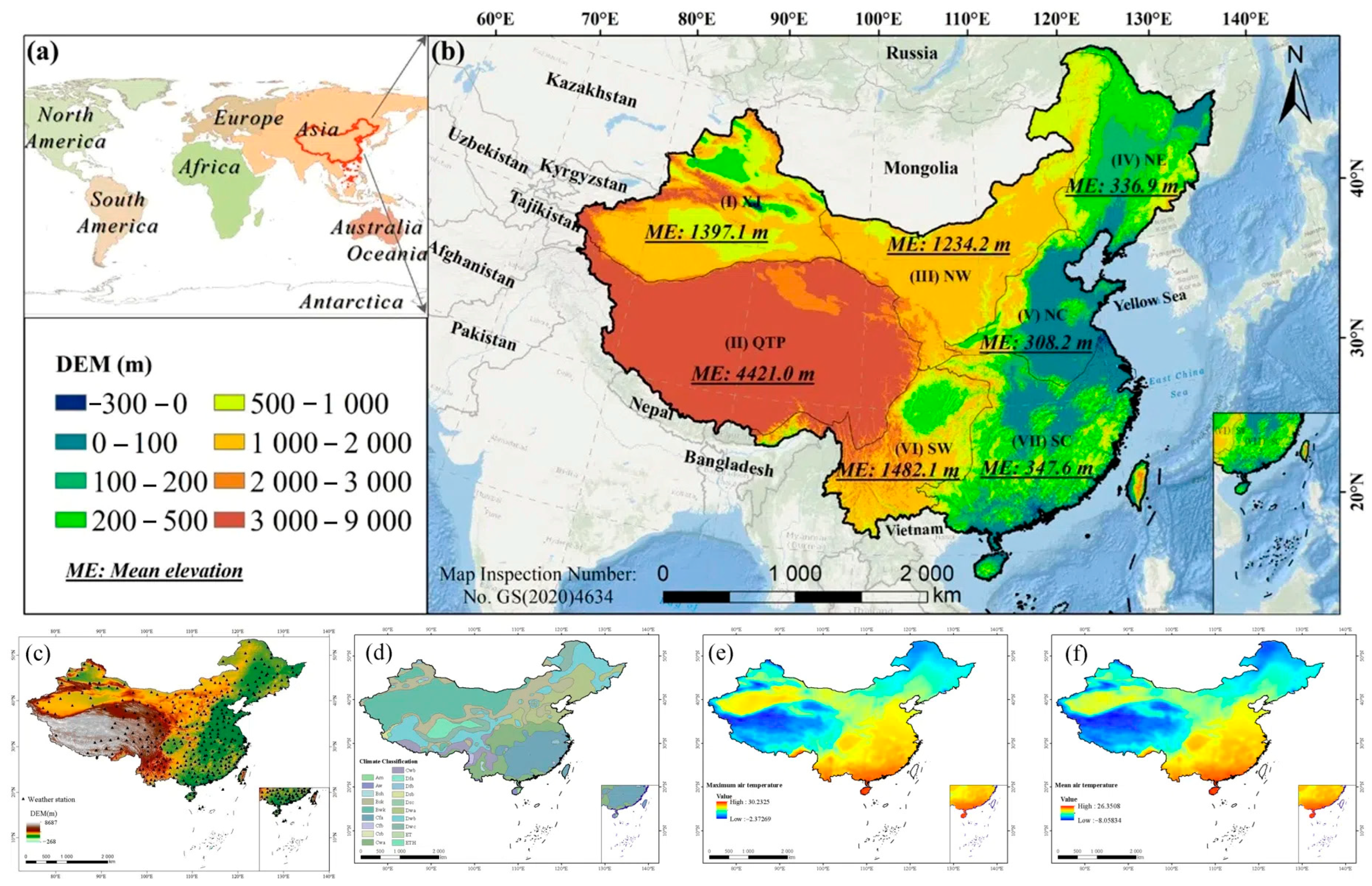

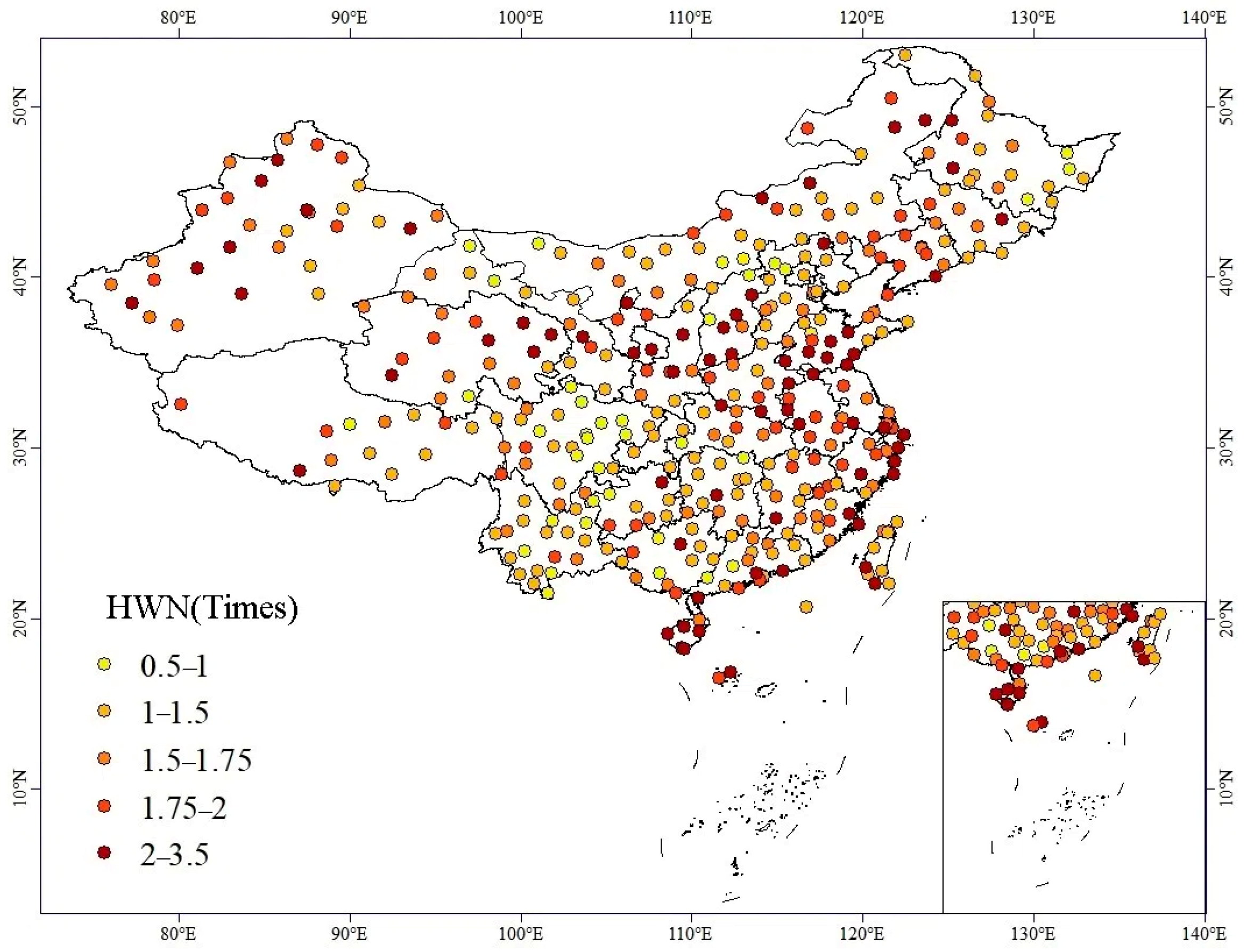
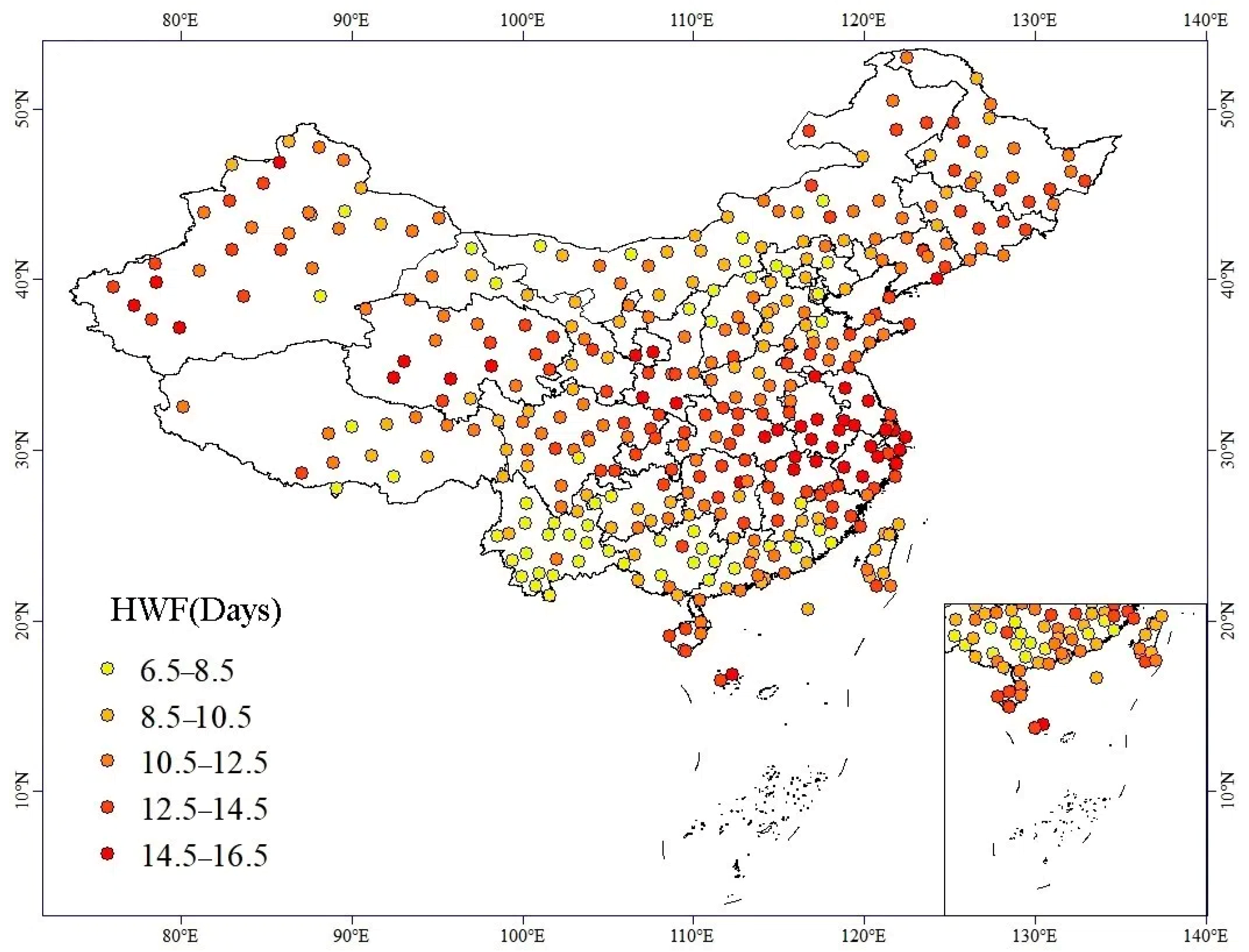
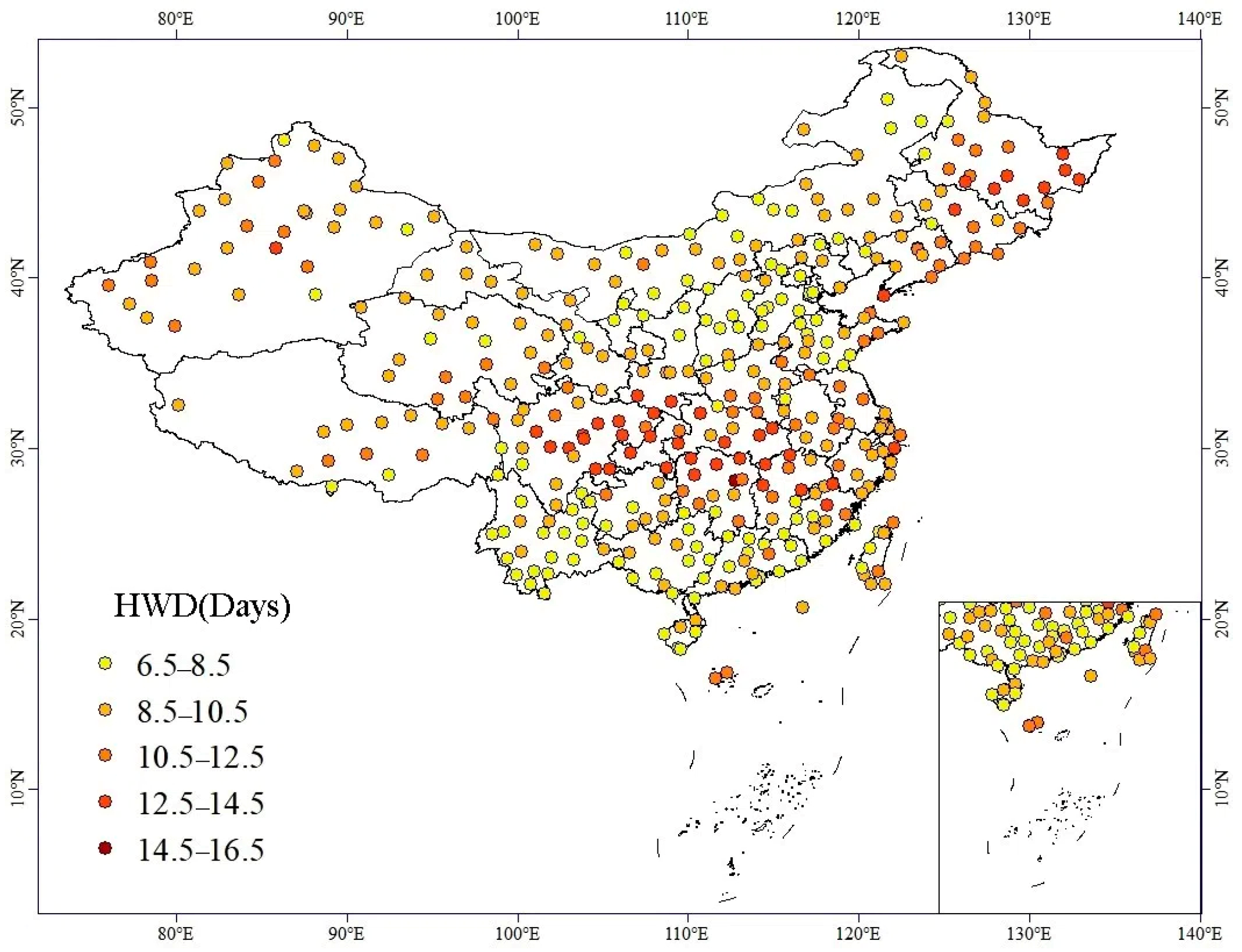


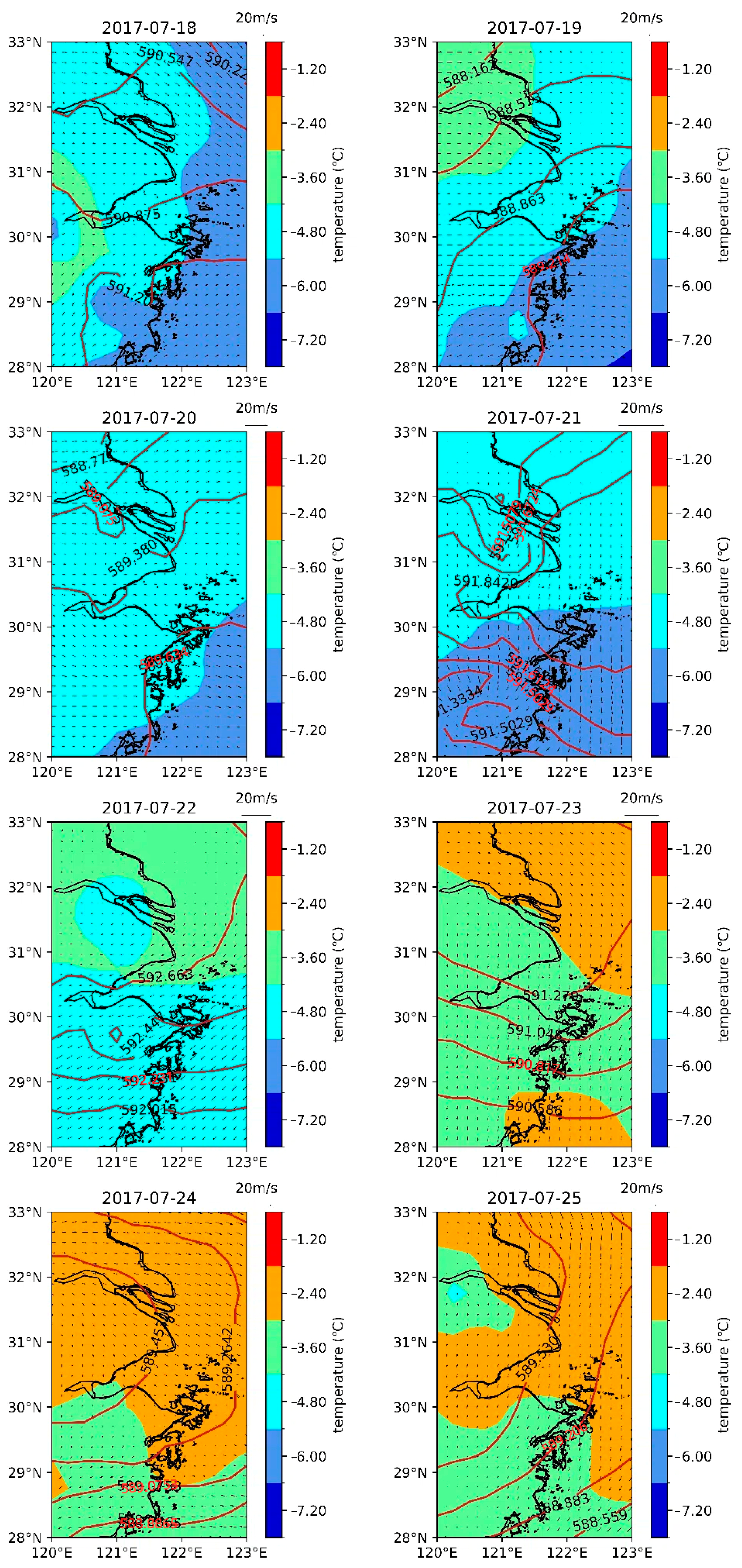
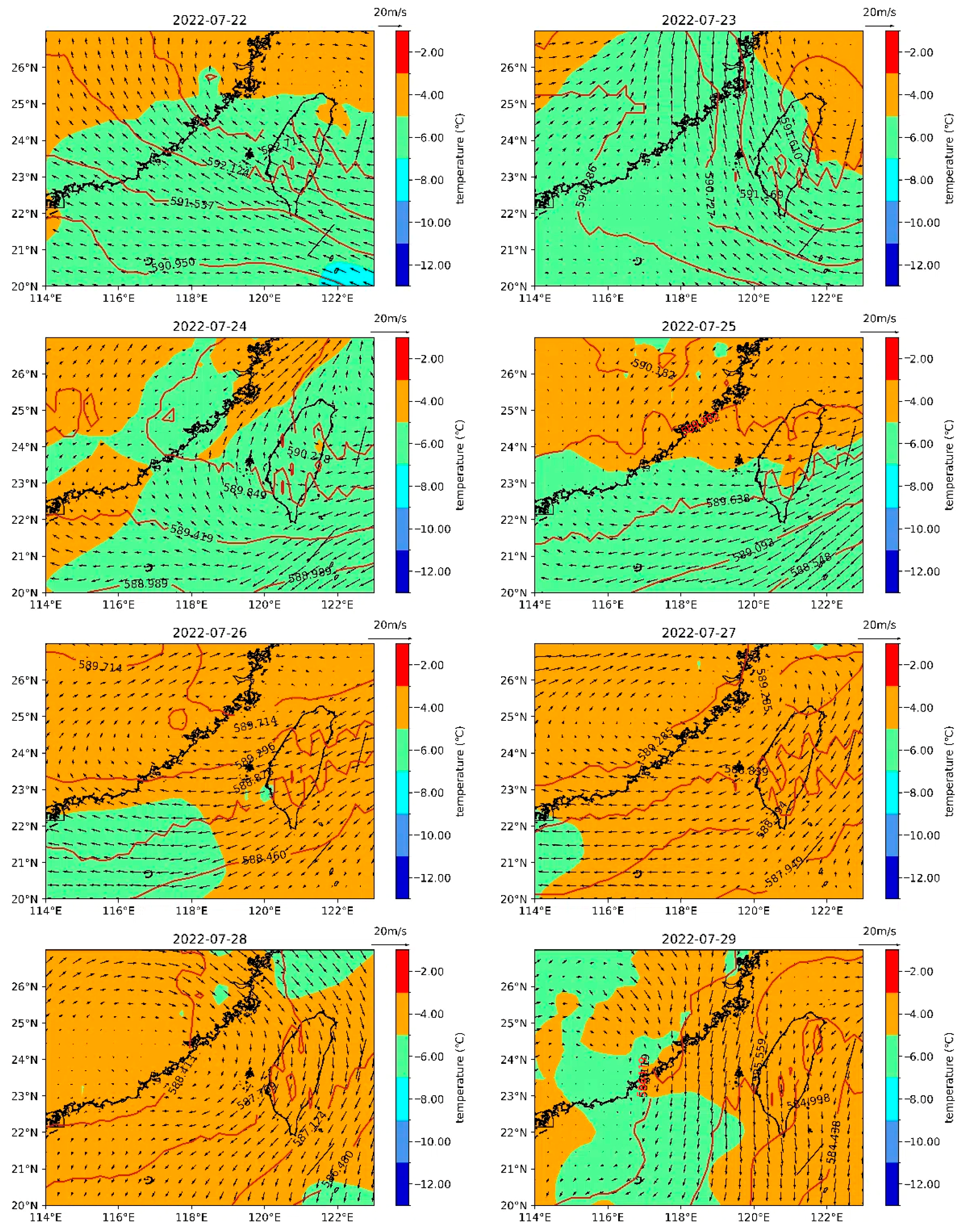


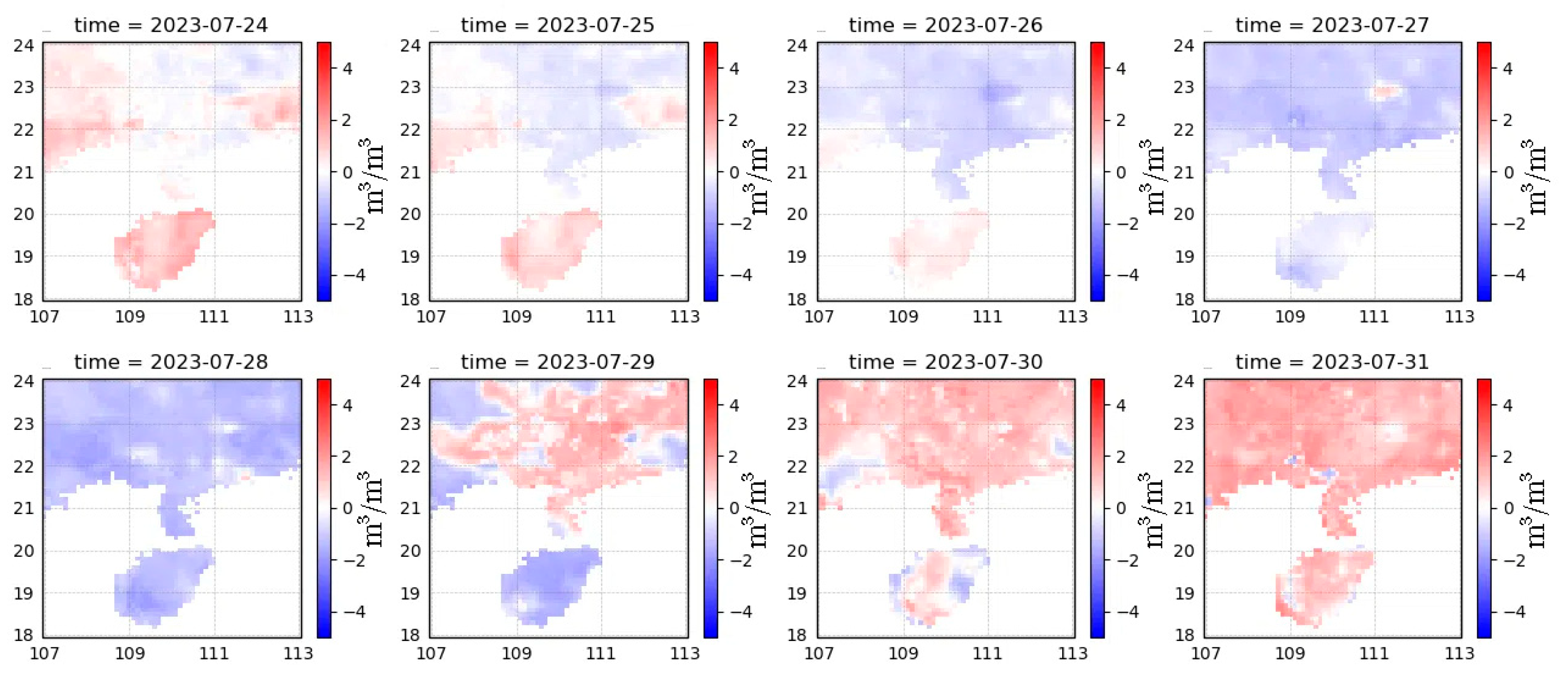
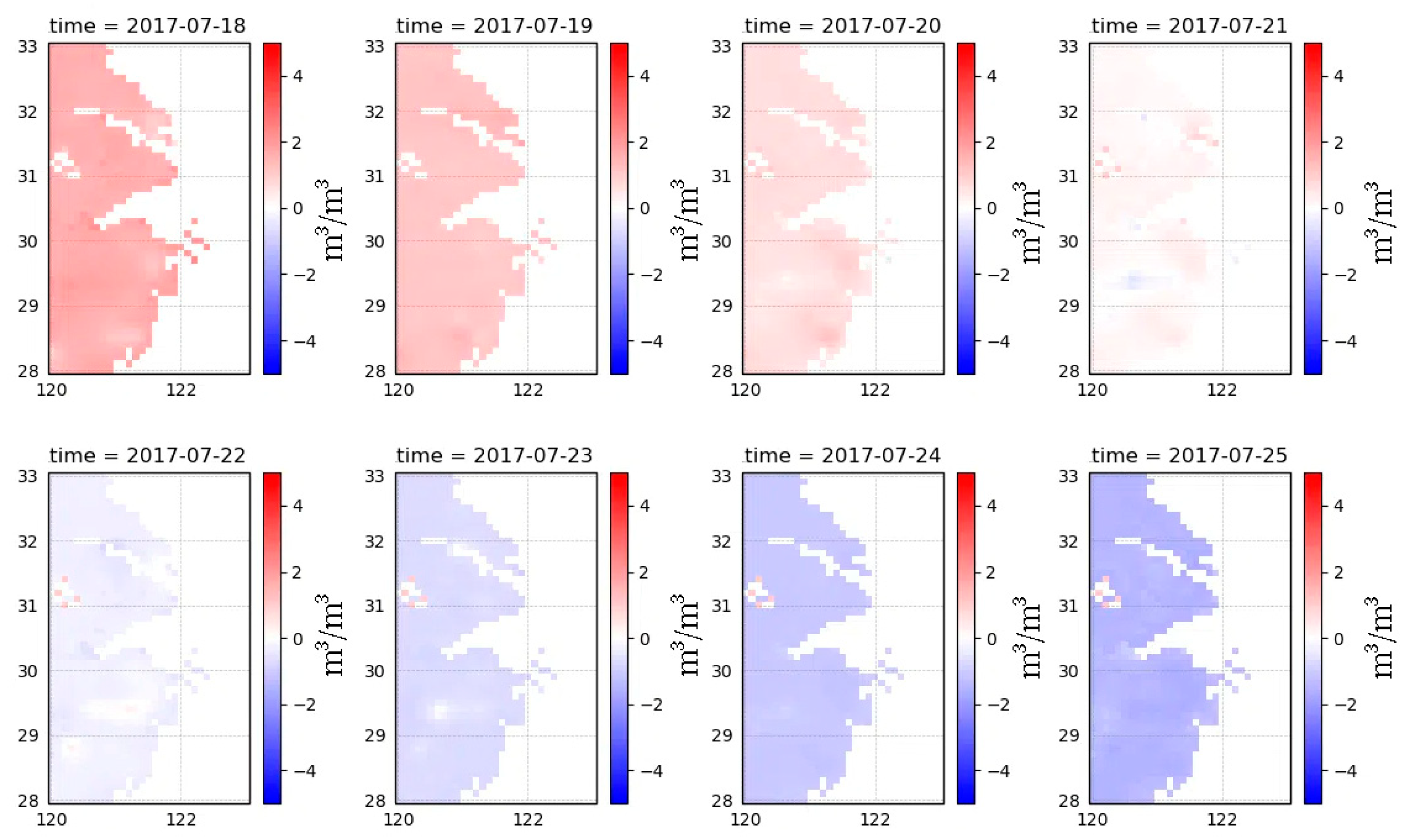

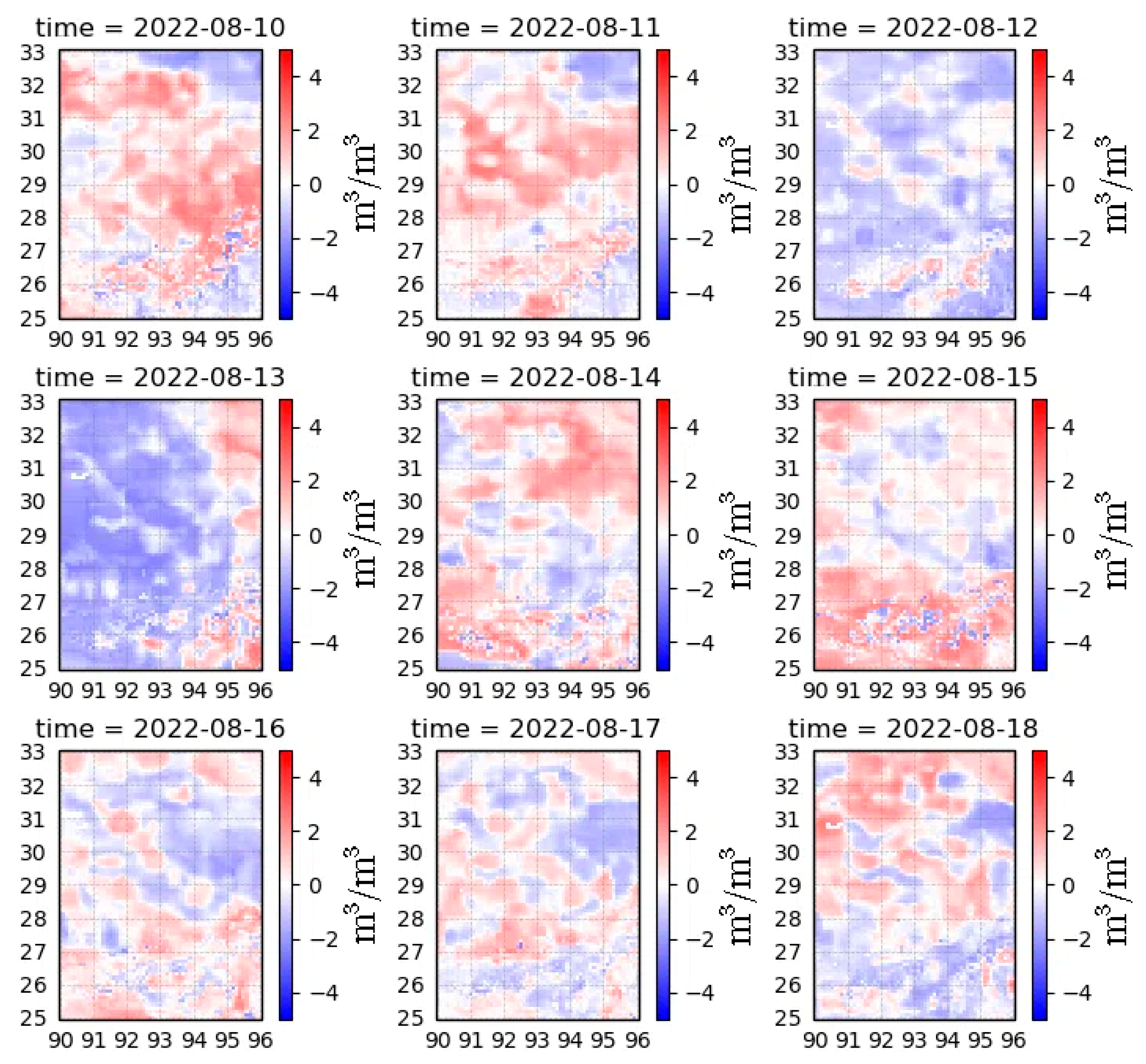
| Indicators | Definition |
|---|---|
| HWN | Number of heatwaves |
| HWF | Number of days with EHF > 0 in heatwave events |
| HWD | Longest consecutive days with EHF > 0 in heatwave events |
| HWI | Highest EHF recorded in heatwave events |
Disclaimer/Publisher’s Note: The statements, opinions and data contained in all publications are solely those of the individual author(s) and contributor(s) and not of MDPI and/or the editor(s). MDPI and/or the editor(s) disclaim responsibility for any injury to people or property resulting from any ideas, methods, instructions or products referred to in the content. |
© 2025 by the authors. Licensee MDPI, Basel, Switzerland. This article is an open access article distributed under the terms and conditions of the Creative Commons Attribution (CC BY) license (https://creativecommons.org/licenses/by/4.0/).
Share and Cite
Liu, J.; Li, M. Characteristics and Driving Mechanisms of Heatwaves in China During July and August. Atmosphere 2025, 16, 434. https://doi.org/10.3390/atmos16040434
Liu J, Li M. Characteristics and Driving Mechanisms of Heatwaves in China During July and August. Atmosphere. 2025; 16(4):434. https://doi.org/10.3390/atmos16040434
Chicago/Turabian StyleLiu, Jinping, and Mingzhe Li. 2025. "Characteristics and Driving Mechanisms of Heatwaves in China During July and August" Atmosphere 16, no. 4: 434. https://doi.org/10.3390/atmos16040434
APA StyleLiu, J., & Li, M. (2025). Characteristics and Driving Mechanisms of Heatwaves in China During July and August. Atmosphere, 16(4), 434. https://doi.org/10.3390/atmos16040434







